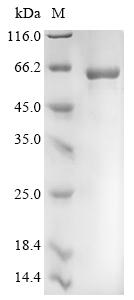Amino acids 21-567 constitute the expression domain of recombinant Human TAS1R1. The theoretical molecular weight of the TAS1R1 protein is 68.1 kDa. This protein is generated in a e.coli-based system. The TAS1R1 coding gene included the N-terminal 10xHis tag and C-terminal Myc tag, which simplifies the detection and purification processes of the recombinant TAS1R1 protein in following stages of expression and purification.
The human taste receptor type 1 member 1 (TAS1R1) is a G protein-coupled receptor (GPCR) that plays a key role in the perception of umami taste, which is associated with savory or meaty flavors. TAS1R1, along with TAS1R2, forms a heterodimeric receptor complex known as T1R1/T1R2, responsible for recognizing amino acids such as glutamate. Activation of TAS1R1/TAS1R2 by umami compounds triggers intracellular signaling cascades, leading to the perception of umami taste. This receptor is primarily expressed in taste receptor cells on the tongue, contributing to the complex sensory experience of taste by detecting specific chemical compounds in food. Understanding TAS1R1's function is crucial for unraveling the molecular basis of taste perception.






